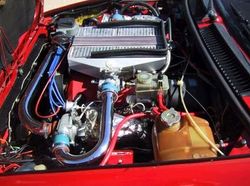Twin-turbo
Twin-Turbo, also called bi-turbo by some, refers to a turbocharged engine, usually larger than 2500 cc, on which two turbochargers compress the intake charge. There are two different twin turbo configurations, parallel twin-turbo and sequential twin-turbo.
Parallel Twin-Turbo
Parallel Twin-Turbo refers to a turbocharger configuration in which two identical turbochargers equally split the turbocharging duties. Each turbocharger is driven by one half of the engine's spent exhaust energy. In most applications, the compressed air from both turbos is combined in a common intake manifold, and sent to the individual cylinders. Both turbos function simultaneously, unlike sequential twin-turbos. Commonly each turbocharger is mounted to its own individual exhaust/turbo manifold, however on inline-type engines both turbochargers could be mounted to a single turbo manifold. Parallel twin turbos are usually applied to V-shaped engines where one turbo is assigned to each cylinder bank, providing packaging symmetry, and simplifying plumbing; however, it is not uncommon for a parallel set-up to be used on an inline engine. Nissan's RB26DETT is an inline-6 that uses a twin-turbo set-up, the twin-turbo inline-6 in the BMW 335i (E90) coupe also utilizes a parallel twin-turbo set-up. Toyota's 1992 Supra with the 1JZ-GTE (Japan only) 6 cylinder inline engine also used this same configuration, as does Nissan's 1990-1996 Z32 300ZX in its V6 VG30DETT.
While a parallel twin-turbo set-up theoretically has less turbo lag than a single turbocharger set up, because of marginally-reduced combined inertial resistance, and often simplified exhaust plumbing, the fact that both turbos spool at more or less the same time means that there is still a noticeable bit of lag, especially in high-flow turbo/high boost applications. One way to counter this is to use a light pressure set up where the turbos are designed to output less boost but spool earlier, however, this set up sacrifices top end power. Another system would be the use of variable geometry turbochargers, this system changes the angle of the guide vanes depending on the exhaust pressure giving the system excellent power throughout the rev range. Once used mainly in turbocharged diesel engines, Porsche was the first to use it in a mass-production gasoline-powered vehicle in 2006 with the 911 Turbo (997).
Sequential Twin-Turbo
Sequential Twin-Turbo refers to a set up in which the motor can utilize only one turbocharger for lower engine speeds, and both turbochargers at higher engine speeds. During low to mid engine speeds, when available spent exhaust energy is minimal, only one turbocharger (the primary turbocharger) is active. During this period, all of the engine's exhaust energy is directed to the primary turbocharger only, lowering the boost threshold, and increasing power output at low engine speeds. Towards the end of this cycle, the secondary turbocharger is partially activated (both compressor and turbine flow) in order to pre-spool the secondary turbocharger prior to its full utilization. Once a preset engine speed or boost pressure is attained, valves controlling compressor and turbine flow through the secondary turbocharger are opened completely. At this point the engine is functioning in a full twin-turbocharger form, providing maximum power output. Sequential twin-turbocharger systems provide a way to decrease turbo lag without compromising ultimate boost output and engine power. Examples of cars with a sequential twin-turbo setup include the actual Volkswagen Golf (Rabbit) MK5 GT 1993-2002 Toyota Supra Turbo (JZA8x), the 1992-2002 Mazda RX-7 Turbo (FD3S), and the 1986-1988 Porsche 959. With recent advancements in turbocharger design, sequential twin turbo systems have fallen out of favor because they are seen as unnecessarily costly and complex.
Alfa Romeo Callaway Twin Turbo GTV-6
Following its success with their turbocharger kits, this led a commission by Alfa Romeo to produce a higher end version of its 2.5 liter GTV-6 coupé. Thirty examples were built between 1983 and 1986. In addition to numerous small component upgrades, the Callaway GTVs included a much revised suspension, larger brakes and a twin-turbocharger system, boosting performance to near-exotic levels.
The car's performance caught the attention of Dave McLellan, Chief Engineer of the Corvette, and would lead to the Callaway-Corvette association it became famous for.
Compound turbocharging
Compound turbocharging is a technique used to achieve extremely high pressure ratios by having one turbocharger pressurize the air coming into the inlet of another. It is common in racing with diesel engines (For example tractor pulling) due to their combustion properties that take well to high boost pressures and are not limited by fuel stability like spark ignition engines. Boost pressures of around seven bar gauge pressure (101 psi) are common and as high as 10 bar (145psi) in some cases. A normal turbocharger has a maximum pressure ratio of around three but there are turbochargers in existence specially designed for high boost which have maximum pressure ratios of typically 4-5. In this configuration one turbocharger is used to pressurize the air coming into the inlet of the other, resulting in a multiplication of the pressure ratios. Same goes for exhaust plumbing. For example if both turbochargers are running at pressure ratios of 3.0 and the atmospheric pressure is one bar the resulting pressures will be three bar absolute pressure at the inlet of the second turbocharger and nine bar absolute pressure (eight bar gauge) at the inlet manifold of the engine. The pressure ratio in this example becomes nine.
An example of an engine utilising this configuration is at Cummins Racing
See also
External links
